Abstract
A flexible chemosensor has been developed based on colorimetric and fluorescent dual modes using tetraphenylethylene-centered tetraaniline (TPE4A) for rapid and sensitive detection of hypochlorite anion. The fluorescent probe TPE4A exhibits a unique aggregation-induced emission (AIE) character which is proved by a blue shift of the fluorescent peak from 544 to 474 nm with the water equivalents increasing. With the addition of hypochlorite in solution, the absorbance of the probe changes and the responding fluorescence color can be observed to change from light green to purple. The detection limit of hypochlorite is 1.80 × 10−4 M in solution, and the visual detection limit is 1.27 µg/cm2 with the naked eye for the flexible paper-based chemosensor. The proposed flexible chemosensors show a good selectivity and sensitivity which has great potential for effective detection of hypochlorite anions without any spectroscopic instrumentation.
1. Introduction
Hypochlorite anion (ClO−) plays an essential role in biological organisms and environmental monitors, which not only is produced by H2O2 and chloride ions in activated neutrophils [1,2,3,4,5] but is also a kind of disinfector which can kill the coronavirus [6,7,8]. However, excessive hypochlorite could lead to diseases and even cancer including cardiovascular diseases, neuron degeneration, and arthritis [9,10]. Therefore, quantitative detection of hypochlorite with highly sensitive and selective methods becomes more and more crucial.
Many various analytical methods are available for the detection of hypochlorite (for example, colorimetric and fluorescent chemosensors) [11,12]. Recent reviews have summarized the advances of hypochlorite probes [13,14]. There are some successful designs for quantitative detection of hypochlorite based on the principle of colorimetric, chromatographic, electrochemical, and luminescent methods. Specifically, the fluorescent probe is a promising method with advantages such as low cytotoxicity, high selectivity, and fast response time for ClO− detection. Moreover, understanding visual detection is an unceasingly thorough process for rapid and sensitive detection of hypochlorite anions [15,16,17,18,19,20,21,22,23,24].
Recently, dual modes [25,26,27] bioanalysis has become a popular research area, wherein researchers are studying scrambly as well. When the environment changes in the direction of complexity, single-switch optical detection may no longer meet the reliability of data and the diversity of application scenarios. Therefore, it is very important to construct a dual-mode optical detection method. The optical detection based on colorimetric and fluorescent dual modes could not only improve the accuracy of results but also lead to higher efficiency. In recent years, flexible thin-film devices [28,29] have been developed vigorously, especially in material, chemical, biological, physical fields, due to their unique advantages such as their low-cost, porosity, ready availability, mechanical flexibility, etc. Therefore, the design of paper-based chemosensors for simple and rapid detection is of great significance. In this work, we present a commercially available material TPE4A for fabricating a flexible paper-based chemosensor based on colorimetric and fluorescent dual modes in Scheme 1.
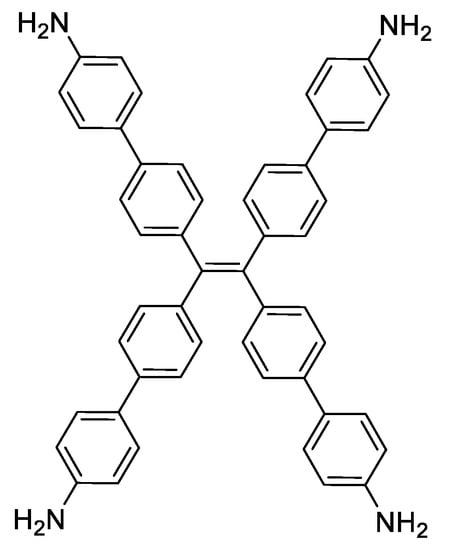
Scheme 1.
The chemical structure of tetraphenylethylene-functionalized molecule TPE4A.
2. Results and Discussion
2.1. NMR Spectra
A commercially available material TPE4A, namely 4′,4‴,4′′′′′,4′′′′′′′-(ethene-1,1,2,2-tetrayl)-tetrakis(([1,1′-biphenyl]-4-amine)) [30,31], has been purchased where the tetraphenylethylene (TPE) group shows an aggregation-induced emission (AIE) character [32,33]. The chemical structure of TPE4A has double checked by NMR spectra in Figure S1. 1H NMR (400 MHz, d6-DMSO): δ 7.37 (d, J = 8.3 Hz, 8H, TPE), 7.34 (d, J = 8.4 Hz, 8H, Phenyl), 7.03 (d, J = 8.3 Hz, 8H, TPE), 6.59 (d, J = 8.4 Hz, 8H, Phenyl), 5.22 (s, 8H, NH2).
2.2. Aggregation-Induced Fluorescent Behavior
With the enhancement of volume fraction of water phase (fw), UV–Vis and fluorescent spectra have been shown for compound TPE4A in Figure 1. A step-by-step fluorescent turn-on is observed from fw = 0 to 70%, due to the controlled rotational motion in the molecule. Interestingly, a remarkable color change occurs from orange when fw = 70% to green when fw = 80% mainly due to the formation of aggregates. Simultaneously, the maximum emission wavelength λmax is from 544 nm when fw = 70% to 474 nm when fw = 80%. Absorption and emission spectra show a clear AIE character for compound TPE4A as expected. The dominant luminescence is from the emissive solution to solid fluorescence. The same phenomenon is observed in the different concentration measurements. According to restriction of intramolecular vibrations (RIV) and restriction of intramolecular rotations (RIR), the possess of twisted intramolecular charge transfer (TICT) also is blocked, resulting in decreasing red-shift and increasing blue-shift.
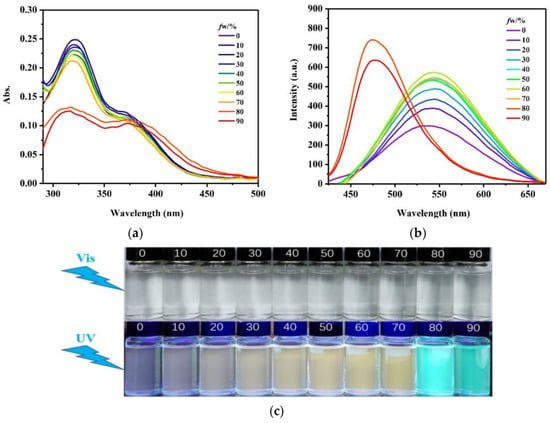
Figure 1.
UV–Vis absorption (a) and fluorescent emission (b) spectra and their visual photograph (c) for compound TPE4A with different fw in their THF/water solutions with the same concentration of 10 µM.
2.3. Titration Experiment of Probe TPE4A
Compared to other chemical anions, molecule TPE4A has been designed as a highly selective fluorescent probe for ClO− anion in Figure 2. After adding 1.00 mM of analytes, such as SCN−, CO32−, S2−, NO2−, H2O2, F−, and ClO−, UV–Vis absorption, and fluorescent intensities of probe TPE4A (40 µM) have been shown in mixed solution (fw = 80%). The absorption peak of TPE4A is from 398 nm to 429 nm (also from 3.12 eV to 2.89 eV) in the presence of ClO−, which is consistent with the results of calculated energy gaps.
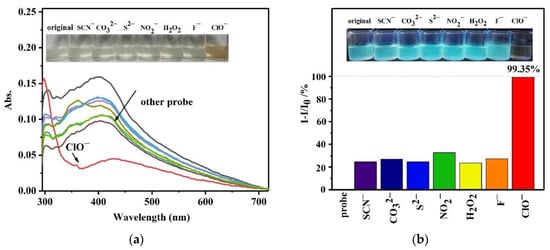
Figure 2.
UV–Vis absorption (a) and fluorescent quenching percentages at 480 nm (b) of probe TPE4A (40 µM) in mixed solution (fw = 80%) upon exposure to other analytes for 60 s. Inset: a colorimetric and fluorescent change photograph for ClO− and other analytes (SCN−, CO32−, S2−, NO2−, H2O2, and F−).
More importantly, a fluorescent quenching occurs from light green to dark, while the emissive color of this probe remains unchanged after the adding of other chemical species. Quantitative titration experiment shows a clear fluorescent turn-off in the presence of different concentrations of hypochlorite anion from 0 to 25 equivalent in mixed solution (fw = 80%) with 100% of quenching percentage in Figure 3. It is noted that the intensity of TPE4A at 480 nm does not significantly change under H2O2 or ClO4− oxidants, since this compound avoids being oxidized in this case.
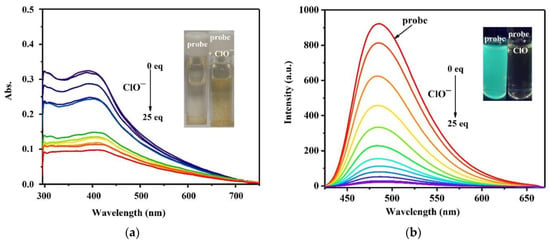
Figure 3.
Absorption (a) and emission (b) titration spectra of the probe TPE4A (40 µM) in the presence of various concentrations of ClO− from 0 to 25 equivalent in mixed solution (fw = 80%). Inset: the contrastive pictures before and after the addition of ClO−.
2.4. Paper-Based Sensor
To effective detection of ClO− in the state of aggregation, we prepared a test paper as the paper-based sensor. Then, we dipped the test paper into a solution containing chromophore test paper. As shown in Figure 4, the SEM diagram indicates that TPE4A can be attached to paper-based fibers. The diameter of particulate matter is approximately 100 µm, while the diameter of melt-blown fibers is 20~50 µm, showing a size matching on a micron scale. We carried out the naked-eye recognition matrix of paper-based sensor TPE4A for different concentrations of ClO− under visible and UV light in Figure 5. The fluorescence of the paper-based sensor is quenched gradually with the increase of the concentration of ClO−. At the same time, the color of the sensor changes from white to yellow under visible light, while from green to purple with the light of the UV lamp at 365 nm. Quantitative analysis demonstrates that the detection limit of hypochlorite is 1.80 × 10−4 M in solution based on the IUPAC definition 139 (CDL = 3 Sb m−1) [34], and the visual detection limit is 1.27 µg/cm2 with the naked eye. Therefore, tetraphenylethylene-centered tetraaniline materials have a rapid and highly sensitive character for more convenient and visual detecting hypochlorite in a few seconds.
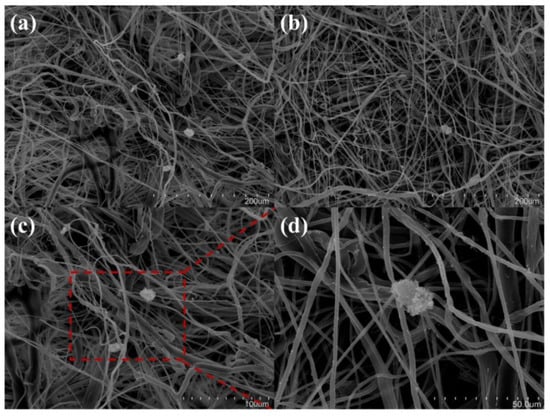
Figure 4.
SEM images in different sizes of paper-based sensor TPE4A: 200 µm (a,b), 100 µm (c), and 50 µm (d).

Figure 5.
The naked-eye recognition matrix diagram of paper-based sensor TPE4A for different concentrations of ClO− under visible and UV light. Original 0 M, (a) 5.0 × 10−4 M, (b) 1.0 × 10−3 M, (c) 5.0 × 10−3 M, (d) 1.0 × 10−2 M, (e) 5.0 × 10−2 M, (f) 1.0 × 10−1 M.
2.5. Possible Mechanism of Probe TPE4A
According to the references [16,35,36], as well as experimental and theoretical calculations [37], we have investigated the possible mechanism of TPE4A in Scheme 2. First of all, the tetraaniline structure may be oxidized to the azo counterpart under an appropriate oxidant in this case. It is noted that perchloride is a stronger oxidant meant it could oxidize the aniline group to form the azo intermediate. However, the solubility of perchloride is limited in fw = 80%. The mechanism of fluorescent turn-off quenching is a reaction from strong chromophore TPE4A to weak chromophore TPE4A-NNCl, which could be speculated that owing to the oxidation of TPE4A. Furthermore, the C–N bond could be easy to cleavage in the azo intermediate and further to form a radical which could combine with chlorine radicals to form the compound TPE4A-NNCl. The energy gap is 3.44 eV for TPE4A, while the energy gap is 3.17 eV for TPE4A-NNCl (see Supporting Information).
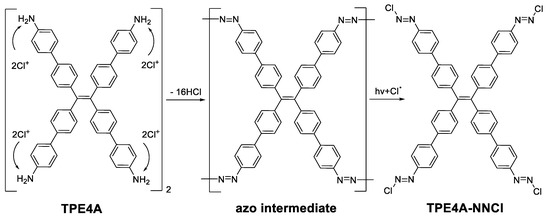
Scheme 2.
Possible mechanism of chemosensor TPE4A for ClO−.
In addition, we carried out the ESI-MS analysis to explore the complete reaction mixture of the probe with ClO− in Figure S3. ESI-MS analysis that a peak at m/z = 837.1954 corresponding to [TPE4A-NNCl-2Cl+Na]+ (calcd for [C50H32Cl2N8Na]+: 837.2019) is clearly observed with other identical isotopic peaks. This promoted a possible method to design fluorescent probes for hypochlorite with the inorganic/organic composites containing amino groups.
3. Conclusions
In summary, we have designed and developed a flexible paper-based material for hypochlorite detection. The quantitative analysis demonstrates that with the enhancement of hypochlorite equivalents, the UV–Vis peaks have been decreasing from 398 nm to 429 nm, while the fluorescent peak at 480 nm has been decreasing more remarkably. Furthermore, the detection limit of hypochlorite is 1.80 × 10−4 M in solution, and the visual detection limit is 1.27 µg/cm2 with the naked eye. The mechanism of fluorescent turn-off quenching is a reaction from strong chromophore TPE4A to weak chromophore TPE4A-NNCl, which has been confirmed by experimental and theoretical results, as well as support from references. This study can provide a flexible paper-based portable chemosensor based on colorimetric and fluorescent dual modes for hypochlorite before conventional chemical synthesis.
Supplementary Materials
The following are available online at https://www.mdpi.com/article/10.3390/s21238082/s1. Figure S1: 1H NMR of TPE4A; Figure S2: The selectivity of TPE4A for ClO−, SCN−, CO32−, S2−, NO2−, H2O2, F− and ClO4−; Figure S3: Fitting plot for compound 1 with the addition of different contentions of TPE4A in THF solution to calculate the limit of detection; Figure S4: The experimental and theoretical ESI-MS of the product obtained by mixing probe NaOCl; Table S1: The HOMOs and LUMOs of compounds TPE4A and TPE4A-NNCl.
Author Contributions
Conceptualization, T.T.; methodology, Q.W.; formal analysis, Q.W. and T.T.; investigation, Q.W.; data curation, Q.W. and T.T.; writing—original draft preparation, Q.W. and T.T.; writing—review and editing, Y.Z. and W.H.; supervision, T.T. and Y.Z.; project administration, T.T.; funding acquisition, T.T. All authors have read and agreed to the published version of the manuscript.
Funding
This work was financially supported by the National Natural Science Foundation of China (No. 21501097), the Natural Science Foundation of Jiangsu Province (Nos. BK20150890 and BK20201389), Qing Lan Project of the Jiangsu Higher Education Institutions of China, and the Startup Foundation for Introducing Talent of NUIST (No. 2014R002) for financial aids.
Institutional Review Board Statement
Not applicable.
Informed Consent Statement
Not applicable.
Data Availability Statement
Not applicable.
Conflicts of Interest
The authors declare no conflict of interest.
References
- Gross, S.; Gammon, S.T.; Moss, B.L.; Rauch, D.; Harding, J.; Heinecke, J.W.; Ratner, L.; Piwnica-Worms, D. Bioluminescence imaging of myeloperoxidase activity in vivo. Nat. Med. 2009, 15, 455–461. [Google Scholar] [CrossRef] [Green Version]
- Reja, S.I.; Bhalla, V.; Sharma, A.; Kaur, G.; Kumar, M. A highly selective fluorescent probe for hypochlorite and its endogenous imaging in living cells. Chem. Commun. 2014, 50, 11911–11914. [Google Scholar] [CrossRef]
- Gui, S.L.; Huang, Y.Y.; Hu, F.; Jin, Y.L.; Zhang, G.X.; Yan, L.S.; Zhang, D.Q.; Zhao, R. Fluorescence turn-on chemosensor for highly selective and sensitive detection and bioimaging of Al3+ in living cells based on ion-induced aggregation. Anal. Chem. 2015, 87, 1470–1474. [Google Scholar] [CrossRef] [PubMed]
- Guo, Z.R.; Hu, T.L.; Sun, T.; Li, T.D.; Chi, H.; Niu, Q.F. A colorimetric and fluorometric oligothiophene-indenedione-based sensor for rapid and highly sensitive detection of cyanide in real samples and bioimaging in living cells. Dyes Pigments 2019, 163, 667–674. [Google Scholar] [CrossRef]
- Xu, H.; Wu, S.L.; Lin, N.J.; Lu, Y.; Xiao, J.; Wang, Y.W.; Peng, Y. A NIR fluorescent probe for rapid turn-on detection and bioimaging of hypochlorite anion. Sens. Actuators B Chem. 2021, 346, 130484. [Google Scholar] [CrossRef]
- Pattison, D.I.; Davies, M.J. Evidence for rapid inter- and intramolecular chlorine transfer reactions of histamine and carnosine chloramines: Implications for the prevention of hypochlorous-acid-mediated damage. Biochemistry 2006, 45, 8152–8162. [Google Scholar] [CrossRef]
- Kohler, A.T.; Rodtoff, A.C.; Labahn, M.; Reinhardt, M.; Truyen, U.; Speck, S. Efficacy of sodium hypochlorite against multidrug-resistant Gram-negative bacteria. J. Hosp. Inf. 2018, 100, E40–E46. [Google Scholar] [CrossRef] [PubMed]
- Chatterjee, A. Use of Hypochlorite Solution as Disinfectant during COVID-19 Outbreak in India: From the Perspective of Human Health and Atmospheric Chemistry. Aerosol Air Qual. Res. 2020, 20, 1516–1519. [Google Scholar] [CrossRef]
- Wang, L.; Long, L.L.; Zhou, L.P.; Wu, Y.J.; Zhang, C.; Han, Z.X.; Wang, J.L.; Da, Z.L. A ratiometric fluorescent probe for highly selective and sensitive detection of hypochlorite based on the oxidation of N-alkylpyridinium. RSC Adv. 2014, 4, 59535–59540. [Google Scholar] [CrossRef]
- Sun, Y.; Gao, Y.; Tang, C.; Dong, G.; Zhao, P.; Peng, D.; Wang, T.; Du, L.; Li, M. Multiple rapid-responsive probes towards hypochlorite detection based on dioxetane luminophore derivatives. J. Pharm. Anal. 2021, in press. [Google Scholar] [CrossRef]
- Jin, L.; Xu, M.Y.; Jiang, H.; Wang, W.L.; Wang, Q.M. A simple fluorescein derived colorimetric and fluorescent ‘off-on’ sensor for the detection of hypochlorite. Anal. Methods 2018, 10, 4562–4569. [Google Scholar] [CrossRef]
- Dongare, P.R.; Gore, A.H. Recent advances in colorimetric and fluorescent chemosensors for ionic species: Design, principle and optical signalling mechanism. ChemistrySelect 2021, 6, 5657–5669. [Google Scholar] [CrossRef]
- Ma, C.G.; Zhong, G.Y.; Zhao, Y.; Zhang, P.; Fu, Y.Q.; Shen, B.X. Recent development of synthetic probes for detection of hypochlorous acid/hypochlorite. Spectrochim. Acta Part A Mol. Biomol. Spectrosc. 2020, 240, 118545. [Google Scholar] [CrossRef]
- Song, Z.-G.; Yuan, Q.; Lv, P.; Chen, K. Research progress of small molecule fluorescent probes for detecting hypochlorite. Sensors 2021, 21, 6326. [Google Scholar] [CrossRef]
- Zhu, B.C.; Xu, Y.H.; Liu, W.Q.; Shao, C.X.; Wu, H.F.; Jiang, H.L.; Du, B.; Zhang, X.L. A highly selective colorimetric probe for fast and sensitive detection of hypochlorite in absolute aqueous solution. Sens. Actuators B Chem. 2014, 191, 473–478. [Google Scholar] [CrossRef]
- Li, J.F.; Huo, F.J.; Yin, C.X. A selective colorimetric and fluorescent probe for the detection of ClO− and its application in bioimaging. RSC Adv. 2014, 4, 44610–44613. [Google Scholar] [CrossRef]
- Yu, S.Y.; Hsu, C.Y.; Chen, W.C.; Wei, L.F.; Wu, S.P. A hypochlorous acid turn-on fluorescent probe based on HOCl-promoted oxime oxidation and its application in cell imaging. Sens. Actuators B Chem. 2014, 196, 203–207. [Google Scholar] [CrossRef]
- Venkatesan, P.; Wu, S.P. A turn-on fluorescent probe for hypochlorous acid based on the oxidation of diphenyl telluride. Analyst 2015, 140, 1349–1355. [Google Scholar] [CrossRef]
- Chen, W.C.; Venkatesan, P.; Wu, S.P. A highly selective turn-on fluorescent probe for hypochlorous acid based on hypochlorous acid-induced oxidative intramolecular cyclization of boron dipyrromethene-hydrazone. Anal. Chim. Acta 2015, 882, 68–75. [Google Scholar] [CrossRef]
- Zhu, H.; Zhang, Z.; Long, S.R.; Du, J.J.; Fan, J.L.; Peng, X.J. Synthesis of an ultrasensitive BODIPY-derived fluorescent probe for detecting HOCl in live cells. Nat. Protoc. 2018, 13, 2348–2361. [Google Scholar] [CrossRef]
- Hwang, S.M.; Kim, A.; Kim, C. A simple hydrazine-based probe bearing anthracene moiety for the highly selective detection of hypochlorite. Inorg. Chem. Commun. 2019, 101, 1–5. [Google Scholar] [CrossRef]
- Hu, Y.; Liu, J.; You, X.; Wang, C.; Li, Z.; Xie, W. A light-up probe for detection of adenosine in urine samples by a combination of an AIE molecule and an aptamer. Sensors 2017, 17, 2246. [Google Scholar] [CrossRef] [Green Version]
- Rha, C.J.; Lee, H.; Kim, C. Development of an azo-naphthol-based probe for detecting hypochlorite (ClO−) via color change in aqueous solution. Inorg. Chem. Commun. 2020, 121, 108244. [Google Scholar] [CrossRef]
- Lee, S.C.; Park, S.; So, H.; Lee, G.; Kim, K.-T.; Kim, C. An acridine-based fluorescent sensor for monitoring ClO− in water samples and zebrafish. Sensors 2020, 20, 4764. [Google Scholar] [CrossRef]
- Zhou, Y.Y.; Zhuang, Y.P.; Li, X.; Agren, H.; Yu, L.; Ding, J.D.; Zhu, L.L. Selective dual-channel imaging on cyanostyryl-modified azulene systems with unimolecularly tunable visible-near infrared luminescence. Chem. Eur. J. 2017, 23, 7642–7647. [Google Scholar] [CrossRef]
- Fang, H.; Gan, Y.T.; Wang, S.R.; Tao, T. A selective and colorimetric chemosensor for fluoride based on dimeric azulene boronate ester. Inorg. Chem. Commun. 2018, 95, 17–21. [Google Scholar] [CrossRef]
- Kim, D.; Jeong, K.; Kwon, J.E.; Park, H.; Lee, S.; Kim, S.; Park, S.Y. Dual-color fluorescent nanoparticles showing perfect color-specific photoswitching for bioimaging and super-resolution microscopy. Nat. Commun. 2019, 10, 3089. [Google Scholar] [CrossRef] [Green Version]
- Zhu, Q.B.; Li, B.; Yang, D.D.; Liu, C.; Feng, S.; Chen, M.L.; Sun, Y.; Tian, Y.N.; Su, X.; Wang, X.M.; et al. A flexible ultrasensitive optoelectronic sensor array for neuromorphic vision systems. Nat. Commun. 2021, 12, 1798. [Google Scholar] [CrossRef]
- Kim, S.; Yun, T.G.; Kang, C.; Son, M.J.; Kang, J.G.; Kim, I.H.; Lee, H.J.; An, C.H.; Hwang, B. Facile fabrication of paper-based silver nanostructure electrodes for flexible printed energy storage system. Mater. Des. 2018, 151, 1–7. [Google Scholar] [CrossRef]
- Jiao, J.J.; Li, Z.J.; Qiao, Z.W.; Li, X.; Liu, Y.; Dong, J.Q.; Jiang, J.W.; Cui, Y. Design and self-assembly of hexahedral coordination cages for cascade reactions. Nat. Commun. 2018, 9, 4423. [Google Scholar] [CrossRef] [Green Version]
- Liu, Y.Z.; Diercks, C.S.; Ma, Y.H.; Lyu, H.; Zhu, C.H.; Alshmimri, S.A.; Alshihri, S.; Yaghi, O.M. 3D covalent organic frameworks of interlocking 1D square ribbons. J. Am. Chem. Soc. 2019, 141, 677–683. [Google Scholar] [CrossRef] [Green Version]
- Huang, L.; Tao, H.; Zhao, S.J.; Yang, K.; Cao, Q.Y.; Lan, M.H. A tetraphenylethylene-based aggregation-induced emission probe for fluorescence turn-on detection of lipopolysaccharide in injectable water with sensitivity down to picomolar. Ind. Eng. Chem. Res. 2020, 59, 8252–8258. [Google Scholar] [CrossRef]
- Zhang, S.S.; Huang, Y.P.; Kong, L.; Zhang, X.J.; Yang, J.X. Aggregation-induced emission-active tetraphenylethylene derivatives containing arylimidazole unit for reversible mechanofluorochromism and selective detection of picric acid. Dyes Pigments 2020, 181, 108574. [Google Scholar] [CrossRef]
- Ding, Y.; Li, X.; Li, T.; Zhu, W.; Xie, Y. α-Monoacylated and α,α′- and α,β′-diacylated dipyrrins as highly sensitive fluorescence “turn-on” zn2+ probes. J. Org. Chem. 2013, 78, 5328–5338. [Google Scholar] [CrossRef]
- Xiong, K.M.; Huo, F.J.; Yin, C.X.; Chu, Y.Y.; Yang, Y.T.; Chao, J.B.; Zheng, A.M. A novel recognition mechanism supported by experiment and theoretical calculation for hypochlorites recognition and its practical application. Sens. Actuators B Chem. 2016, 224, 307–314. [Google Scholar] [CrossRef]
- Cheng, X.H.; Jia, H.Z.; Long, T.; Feng, J.; Qin, J.G.; Li, Z. A “turn-on” fluorescent probe for hypochlorous acid: Convenient synthesis, good sensing performance, and a new design strategy by the removal of C=N isomerization. Chem. Commun. 2011, 47, 11978–11980. [Google Scholar] [CrossRef]
- Frisch, M.J.; Trucks, G.W.; Schlegel, J.; Scuseria, G.E.; Robb, M.A.; Cheeseman, J.R.; Schlegel, H.B.; Scalmani, G.; Barone, V.; Mennucci, B.; et al. Gaussian 09, Revision C.01; Gaussian, Inc.: Wallingford, CT, USA, 2010. [Google Scholar]
Publisher’s Note: MDPI stays neutral with regard to jurisdictional claims in published maps and institutional affiliations. |
© 2021 by the authors. Licensee MDPI, Basel, Switzerland. This article is an open access article distributed under the terms and conditions of the Creative Commons Attribution (CC BY) license (https://creativecommons.org/licenses/by/4.0/).